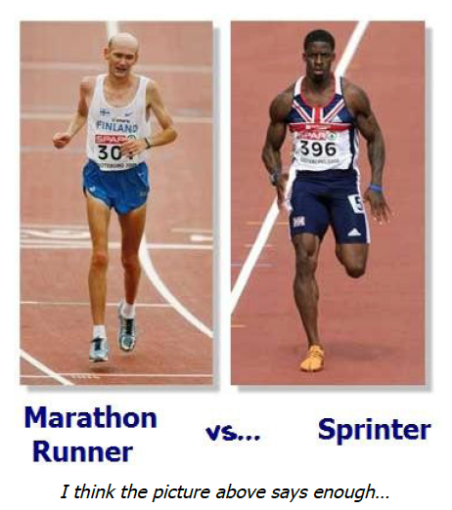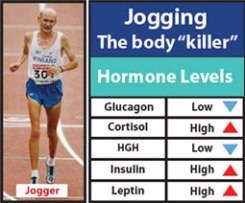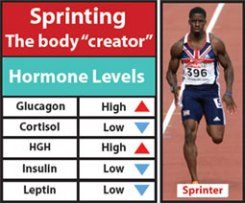Posts Tagged Cedar Rapids Chiropractic
Jogging: The Body Killer
Posted by codyscharfdc in Uncategorized on July 30, 2012
This article is for the joggers, the recreational runner, the marathon runners, and even for those that are thinking about training for a marathon or picking up “jogging.” Let me give you some advice…..STOP! For some, this may be confusing, or even a bit offensive for the avid, overly obsessed runner (and I do intend to hear some negative feedback for this article).But whether your goals are to stay fit or just lose weight, there are better, more efficient ways to go about this. Now I am not totally against recreational jogging or long distance running, in fact, I applaud you for at least doing something, but I want to break it down for you so you know exactly what you are doing to yourself when you go out for that daily jog over an extended length of time. I have broken this down to a Good, Bad, and Ugly version and then give you what you should be doing to meet that cardio need of yours! Let’s get started!
The Good
LISS cardio, or Low Intensity Steady State cardio, is exactly what the acronym stands for; long, slow and steady cardio (jogging/walking). The benefit to LISS is that it IS good for the heart. LISS can reduce blood pressure, increase work capacity, and help with weight loss, which is why many people start a jogging or running routine in the first place. LISS even increases a person’s metabolism which burns more calories up to a couple hours after running is done. LISS is much safer than HIIT cardio, High Intensity Interval Training cardio, which can lead to more injury and overtraining if not done properly. Many times LISS is also the only cardio option available for some who may have physical, or even psychological reasons to avoid a higher intensity training technique. Now if you are using LISS type techniques by walking, you avoid even more stress being put on the body and reduce the amount of wear and tear, but you do not burn near as many calories. It is clear that there is a time and place for LISS activities like jogging, and everyone doing this type of training should see some sort of benefit (in the short term). I cannot stress enough that ANY kind of exercise is better than no exercise at all!
I am glad I we got that out of the way. Now let’s move on….
The Bad
First ask yourself one thing. Have you ever met a runner that hasn’t complained about their ankles, knees, low back or hips? I haven’t. Why is that? Let me explain.
The average height of a woman in the United States is 5’5” and the average height of an American male is 5’9.” To give us a rough estimate of stride length for a typical male and woman, we would have to find a happy medium between a sprint and walk. In order to do this we must take our height in inches and multiply .883 (the factor for finding stride length between walking and sprinting). When we do this we come up with an average stride of just over 5 feet for men and just under 5 feet for woman. For arguments sake well keep it at 5 feet.
If you were to run a mile, a mile is 5,280 feet, that means that on average the normal person is taking atleast 1,050 strides ( This does not take into account any dysfunction or imbalances that may be present that shorten the stride length). According to Saucony Shoe Company, a runner can experience force up to 7x a person’s bodyweight. Using the average weight of a typical American at 180 pounds (if you weigh under this consider yourself lucky), that is upwards of 1000 pounds of force per stride! When we multiply that over a mile it is close to 1 million pounds of force applied to your body! For you marathon runners out there, multiply that by 26.2 and you have…A REALLY, BIG NUMBER (26.2 million pounds of force experienced).
Now knowing that each structure and tissue of the body is only able to take so much load, or stress, before it becomes dysfunctional and starts to break down (see my earlier posts on load/capacity), it is literally only a matter of time before a recreational runner begins to literally break down! With forces like this being experienced, many times on a daily basis, it is no wonder why so many runners break down over time, especially in the ankles, knees, and hips where the load is being transmitted.
Unfortunately, this is only the tip of the iceberg when it comes to problems with jogging and recreational running.
The Ugly
What is worse than chronic wear and tear on your body? Altered hormones! Yes! You heard correctly, running alters your bodies normal, healthy hormones!
If you watch the Olympics in the coming days (and I sure hope you do) compare the body structure of a sprinter and a long distance runner. What you should notice is a considerable difference in muscle mass AND body fat percentage! Here is a comparison.
Both individuals are world class athletes. One is the picture of what a human should look like while the other looks like a Holocaust survivor. The difference, besides the obvious body composition, lies in the hormone levels. If you take a look at some of the most important hormones in your body for health and fitness (Glucagon, Insulin, HGH, Leptin, and Cortisol) you will see that the sprinter and the “jogger” are on completely different ends of the spectrum.
When you look at the “jogger” you will see that glucagon, the hormone responsible for helping to raise low blood sugar and help with fat loss during exercise, and HGH (human growth hormone) a hormone responsible for muscle growth and performance are extremely low. Insulin, the hormone responsible for lowering blood sugar and storing sugars in the bloodstream as fat, leptin, the hormone for hunger, and cortisol, a stress hormone that makes it more difficult to lose weight are all increased dramatically. So now, not only during your long runs are you adding even more stress to your body, you are actually making it harder to lose the fat and build muscle, all the while making you more hungry! The complete opposite goals of exercise and fitness!
Looking at our sprinter counterpart you will see that the hormones are reversed. Glucagon and HGH are high and Insulin, leptin, and cortisol are low, making their bodies efficient fat-busting, muscle-building machines.
The Solution?
The Solution is quite simple really. Start practicing HIIT (high intensity interval training during your runs. If you are new to interval training, start easy. Jog for two minutes for a warm-up (yes I said jog), then go all out for 30 seconds, after the sprint resume your jog, or walk, or even just rest. Repeat this process for up to 20 minutes. Or after a light warm-up, sprint 40 yards, walk back to the starting position, and repeat 10 times. It could be just as easy as finding a hill, sprinting up it, walking back down, and repeating this process 5 times. It is just that simple. When that becomes easy, start reducing the rest periods and/or increase the sprint times, distances, or amount. Make sure that you are exerting yourself to the max though during your sprints. This should be harder than your jog!
By following these instructions, not only will you get your running “fix” in, you will be training more effectively and efficiently, saving you time and altering your body! So stop running now (and thank me later)!


